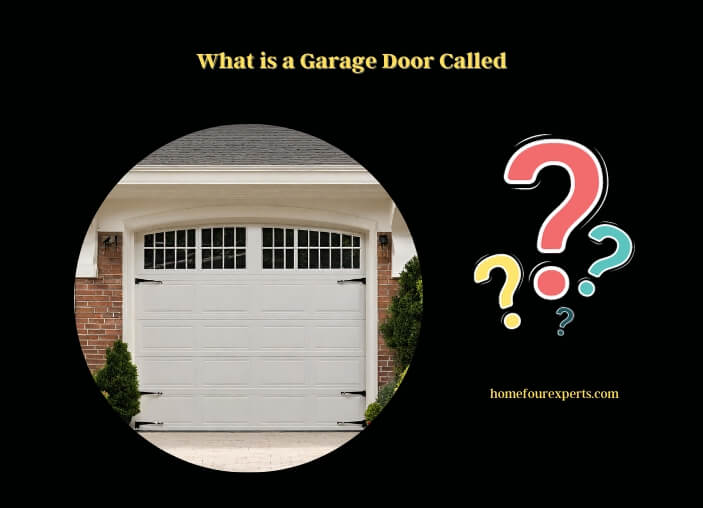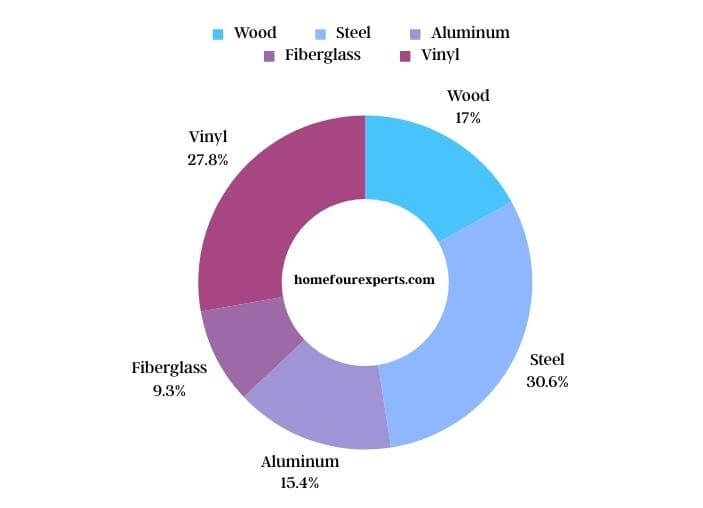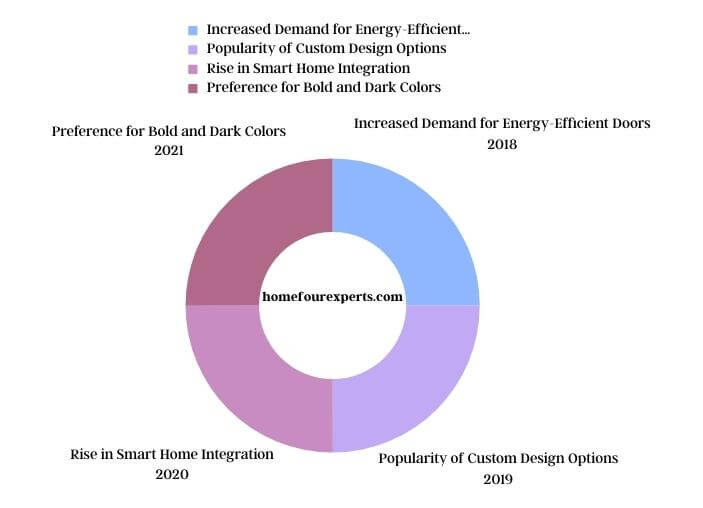A garage door is commonly referred to as an overhead door or a sectional door. It is a large, movable structure that covers the entrance of a garage.
Garage doors come in various types, each with unique features and benefits. The tilt-up garage door, a single solid piece, pivots out and up, forming a canopy outside the garage. Side-hinged garage doors, resembling traditional doors, swing open from a hinged frame on either side of the opening. They offer a classic aesthetic and are ideal for garages with limited headroom.
The sectional garage door is popular due to its space-saving design. It consists of panel sections connected with hinges, allowing it to bend and follow a curved path as it opens and closes. This type is particularly beneficial for those who need to maximize their garage space. Roll-up garage doors, also known as roller doors, operate by rolling up around a cylinder above the door opening, making them suitable for garages with limited ceiling space.

For those interested in the mechanics of garage doors, the garage door opener is a motorized device that opens and closes the door, usually controlled by a remote. Counterweight garage doors, on the other hand, use a weight or spring system to ease the door’s movement, making them easier to operate manually.
There are five primary types of garage doors: sectional, roll-up, slide to the side, side-hinged, and tilt-up canopy. Each type offers different advantages, catering to various preferences and architectural styles.
For a more detailed understanding of each garage door type and to find the perfect fit for your home, we invite you to read the comprehensive article below.
Garage Doors Decoded – Names, Types, and Mechanics
The Evolution of Garage Doors
Early Beginnings to Modern Innovations
Garage doors have come a long way from their humble beginnings. Initially, they were simple wooden gates that swung outward. Over time, as vehicles became more common, the need for a more practical design emerged. This led to the development of the overhead garage door in the early 20th century. Since then, innovations in materials, technology, and design have transformed garage doors into sophisticated elements of modern homes.
Timeline of Garage Door Developments
| Year | Development |
| 1921 | Invention of the Overhead Garage Door |
| 1926 | Introduction of the Electric Garage Door Opener |
| 1950s | Emergence of Fiberglass and Steel Doors |
| 1980s | Advancement in Automatic Garage Door Technology |
| 2000s | Introduction of Smart Garage Door Openers |

Different Types of Garage Doors
Sectional Garage Doors
Sectional garage doors are the most popular in the US. They consist of panel sections connected by hinges. As the door opens and closes, wheels at the edge of each panel roll inside a vertical track on each side of the door opening. The hinges between each panel section bend over a curved portion of the track, allowing the door to sit parallel to the ceiling when open or in line with the walls when closed.
Roll-Up Garage Doors
Roll-up garage doors are more common in commercial applications but are gaining popularity in residential areas for their space-saving design. They work by coiling up a steel curtain around a drum above the door opening. These doors are known for their durability and high-security features.
Slide to the Side Garage Doors
The slide to the side garage door operates just as its name suggests. It bends to one side of the garage and sits parallel to the wall. This style is ideal for garages with limited headroom and is one of the earliest garage door designs.
Side-Hinged Garage Doors
Resembling the traditional barn doors, side-hinged garage doors swing open and closed from a hinged frame on either side of the opening. They are often made of wood, giving a classic look, and are ideal for garages with obstruction or limited headroom.
Tilt-Up/Up and Over Canopy Doors
Tilt-up canopy garage doors are a single solid piece that tilts up into the garage. When open, part of the door protrudes outside, forming a canopy. They are simple in design and operation, making them a budget-friendly option.
Tilt-Up/Up and Over Retractable Doors
Similar to the canopy style, the retractable version also tilts up into the garage but does not protrude outside. It is suspended independently from the frame, making it a more versatile but slightly more expensive option.
Mechanisms Behind Garage Doors
The Functioning of Different Door Types
Each type of garage door has a unique mechanism. Sectional doors use a system of tracks and rollers, while tilt-up doors operate with a pivot and counterbalance system. Roll-up doors involve a drum-like mechanism, and side-hinged doors work with a simple hinge mechanism.
The Role of Garage Door Openers
Garage door openers are motorized devices that open and close garage doors. Most are operated by switches on the garage wall or by remote controls carried by the owner. The opener does not do the actual lifting but provides some initial force to get the door moving.
Manual vs. Automated Systems
While automated garage doors are prevalent, manual doors are still in use, especially in older homes or where cost is a factor. Automated doors offer convenience and improved security but require electricity and regular maintenance.
Materials Used in Garage Doors
Common Materials: Wood, Steel, Aluminum, Fiberglass, Vinyl
Garage doors are made from various materials, each offering different benefits. Wood doors offer a classic look but require more maintenance. Steel is durable and low-maintenance. Aluminum is lightweight and resistant to rust, ideal for coastal areas. Fiberglass is versatile in design but can fade with exposure to sunlight. Vinyl doors are durable and require little maintenance.
Pros and Cons of Each Material
- Wood: Aesthetically pleasing but requires regular refinishing.
- Steel: Strong and secure but can dent and rust.
- Aluminum: Lightweight and rustproof but less durable against impacts.
- Fiberglass: Versatile in appearance but less durable in extreme temperatures.
- Vinyl: Durable and low maintenance but limited in design options.
Comparison of Garage Door Materials
| Material | Durability | Maintenance | Cost |
| Wood | Medium | High | High |
| Steel | High | Medium | Medium |
| Aluminum | Medium | Low | Medium |
| Fiberglass | Low | Medium | Medium |
| Vinyl | High | Low | Medium |

Garage Door Designs and Aesthetics
Customization and Style Options
Today’s garage doors offer a wide range of customization options. You can choose from different colors, finishes, window inserts, and hardware to match your home’s architecture. Whether you prefer a traditional or modern look, there’s a garage door style to suit your taste.
Impact on Home’s Curb Appeal
A garage door can significantly impact a home’s curb appeal. It can complement the home’s style and even increase property value. Choosing the right design and color that blends with the rest of your home is key.
Popular Trends in Garage Door Designs
Current trends in garage door designs include minimalist styles with clean lines, rustic barn-door-inspired designs, and doors with bold, modern colors. Glass panels are also popular for a contemporary look.
Market Trends and Consumer Preferences
Shifts in Consumer Choices Over the Years
Consumer preferences in garage doors have shifted over the years. Initially, functionality was the primary concern, but now, aesthetics and technology play a significant role. Homeowners are looking for doors that not only secure their garage but also enhance the overall look of their home.
Recent Market Trends in Garage Door Preferences
| Year | Trend |
| 2018 | Increased Demand for Energy-Efficient Doors |
| 2019 | Popularity of Custom Design Options |
| 2020 | Rise in Smart Home Integration |
| 2021 | Preference for Bold and Dark Colors |

FAQs
What Is the Origin of the Term “Garage Door”?
The term “garage door” originated in the early 20th century with the rise of the automobile industry. As cars became more common, people needed a place to store them. This led to the construction of garages, and subsequently, large doors to secure these spaces. The term combines “garage,” derived from the French word “garer,” meaning to shelter or protect, and “door,” from the Old English “dor,” meaning a gate or barrier. Together, they describe a door designed specifically for a garage, a concept that evolved with the automobile’s popularity.
Can Garage Doors Be Customized to Match Historical Architecture?
Yes, garage doors can be customized to match historical architecture. Many manufacturers offer custom design services to create doors that complement the architectural style of historic homes. This includes selecting materials like wood that can be carved or shaped to match period-specific designs. Additionally, details such as custom color finishes, decorative hardware, and window styles can be tailored to reflect historical accuracy. This customization allows homeowners to maintain the aesthetic integrity of their historic homes while enjoying the functionality of a modern garage door.
Are There Garage Doors Designed for Extreme Weather Conditions?
Garage doors designed for extreme weather conditions are available and are known as storm-ready or hurricane-rated garage doors. These doors are built to withstand high winds, heavy rain, and other severe weather elements. They are typically made from reinforced steel or other durable materials and include additional bracing and stronger tracks. Some also feature weather seals to prevent water and wind infiltration. These doors are essential in areas prone to hurricanes, tornadoes, or other extreme weather events, providing an added layer of protection for homes.
How Do Garage Doors Contribute to Home Energy Efficiency?
Garage doors contribute to home energy efficiency in several ways. Modern garage doors often come with insulation, which helps regulate temperature in the garage and, by extension, the entire home. This insulation reduces the amount of heat lost during winter and keeps the garage cooler during summer, leading to lower heating and cooling costs. Additionally, well-sealed garage doors prevent drafts and air leaks, further enhancing energy efficiency. Choosing a garage door with good insulation and airtight seals is a practical step towards reducing energy consumption and costs.
What Safety Features Are Essential for Garage Doors?
Safety features essential for garage doors include auto-reverse mechanisms, motion detection sensors, and manual control options. The auto-reverse mechanism ensures that the door reverses direction if it encounters an obstruction, preventing injury or damage. Motion detection sensors stop the door from closing if movement is detected under the door. Manual controls, such as a release mechanism, are crucial in case of power outages, allowing the door to be operated manually. Regular maintenance and testing of these safety features are also important to ensure they function correctly.
How Has Technology Influenced Modern Garage Door Designs?
Technology has significantly influenced modern garage door designs, introducing features like remote control operation, smart home integration, and enhanced security measures. Remote controls allow users to open or close their garage doors from a distance, adding convenience. Smart home technology enables homeowners to control and monitor their garage doors via smartphones, integrating them with other home automation systems. Enhanced security features include rolling codes for remote controls and built-in alarms, which increase protection against unauthorized access. These technological advancements have made garage doors more convenient, secure, and compatible with modern lifestyles.
What Are the Environmental Considerations in Garage Door Manufacturing?
Environmental considerations in garage door manufacturing include the use of sustainable materials, energy-efficient production processes, and recyclability. Manufacturers are increasingly using eco-friendly materials like recycled steel or sustainable wood sources to reduce environmental impact. Energy-efficient production processes aim to minimize carbon footprint, involving reduced energy consumption and waste during manufacturing. Additionally, the end-of-life recyclability of garage doors is a growing consideration, with manufacturers designing doors that can be easily disassembled and recycled, reducing landfill waste. These environmental considerations reflect a growing trend towards sustainability in the garage door industry.
In this article, we’ve taken a journey through the world of garage doors, examining their evolution, types, mechanisms, materials, design trends, and market preferences. From the early days of simple swing-out doors to today’s high-tech, aesthetically pleasing options, garage doors have become an integral part of home design and functionality. Whether you’re in the market for a new garage door or just curious about them, understanding these aspects can help you appreciate the role and importance of garage doors in modern homes.
About This Writer

Hi, I am Eric Devin and I am a professional interior architect. Since childhood, I've always enjoyed DIY projects! And, I have loved to solve simple household problems using essential tools and equipment. I have also acquired a lot of information about basic household tools settings by working with contractors.